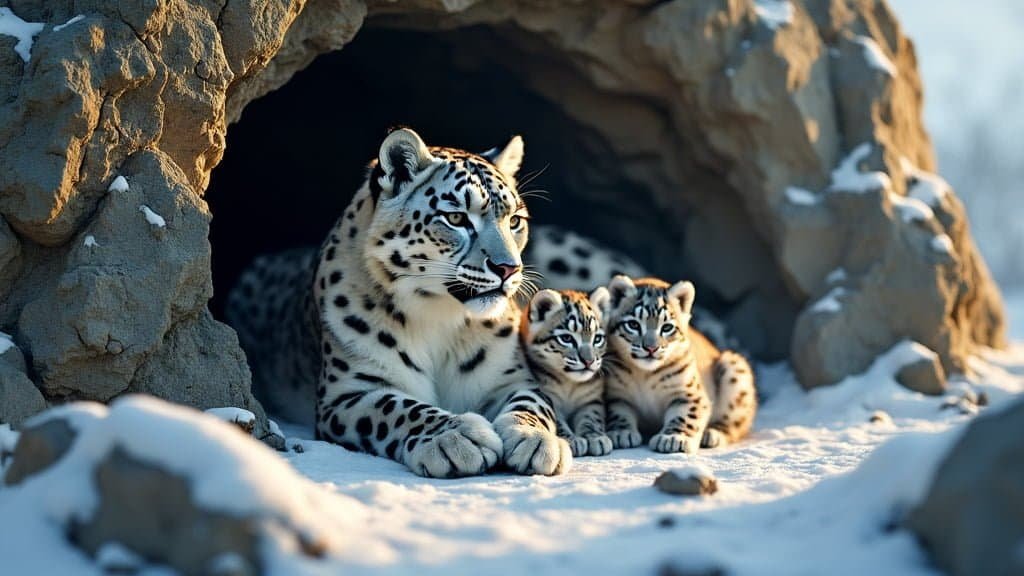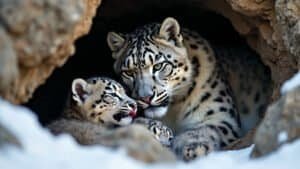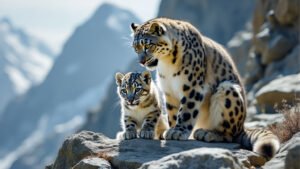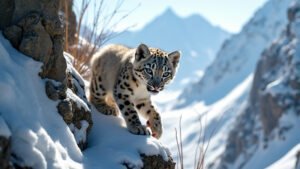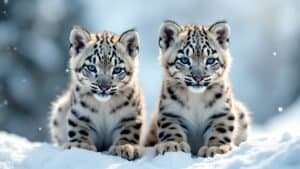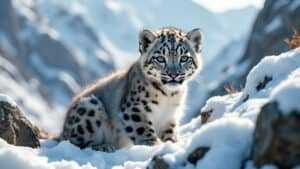Introduction
Snow leopards, known for their elusive nature and stunning beauty, inhabit the rugged mountainous regions of Central and South Asia. Understanding their reproduction habits provides valuable insights into their behavior and conservation needs
This article explores the average litter size of snow leopards, factors influencing the number of cubs, their reproductive cycle, and the care and development of their cubs
We will also examine the survival challenges these cubs face in the wild, shedding light on the critical aspects of snow leopard conservation
Average Litter Size of Snow Leopards
Typical Number of Cubs
Snow leopards typically give birth to a litter of 2 to 3 cubs. However, litters can range from 1 to 5 cubs, with 2 or 3 being the most common
These elusive big cats, scientifically known as Panthera uncia, usually breed once every two years, giving birth in the spring or early summer. The exact number of cubs can vary based on several factors, including the health and age of the mother, environmental conditions, and availability of prey
Factors Affecting Litter Size
Several factors influence the litter size of snow leopards:
Maternal Health: A healthy female is more likely to have a larger litter. Malnutrition or illness can lead to smaller litters or, in some cases, unsuccessful pregnancies
Age of the Mother: Younger and older females tend to have smaller litters compared to those in their prime reproductive years
Environmental Conditions: Harsh weather and scarcity of prey can result in smaller litters. Snow leopards in regions with abundant prey and favorable weather conditions typically have more cubs
Genetic Factors: Genetics can also play a role in determining litter size. Some females are naturally predisposed to having larger or smaller litters
Habitat Quality: High-quality habitats with ample food sources support larger litters, while poor habitats with limited resources may result in fewer cubs per litter
Regional Differences in Litter Size
Snow leopards inhabit a wide range of territories, from the Himalayas to the Altai Mountains
Litter sizes can vary slightly depending on the region:
Himalayan Region: Studies indicate that snow leopards in the Himalayas tend to have slightly larger litters, often averaging 3 cubs. This may be due to the relatively abundant prey and favorable climatic conditions
Central Asian Mountains: In contrast, snow leopards in the central Asian mountains often have smaller litters, averaging around 2 cubs. The harsher climate and variable prey availability in these regions likely contribute to this difference
Mongolian and Siberian Regions: In the more extreme northern ranges, such as Mongolia and Siberia, snow leopards may have smaller litters, typically 1 to 2 cubs. The severe weather conditions and sparse prey in these areas pose significant challenges to both the mothers and their cubs
Research conducted by the Snow Leopard Trust and other conservation organizations has provided valuable insights into snow leopard reproduction
A study published in Oryx – The International Journal of Conservation in 2016 by Dr. Koustubh Sharma and colleagues examined snow leopard births across different regions. They found that the average litter size was 2.3 cubs, with regional variations influenced by environmental and ecological factors
Snow Leopard Reproductive Cycle
Frequency of Births
Snow leopards typically breed once every two years. Females reach sexual maturity at around two to three years of age, while males mature slightly later, at around four years
The breeding season generally occurs from January to mid-March, with most births taking place between April and June. The biennial breeding pattern allows females ample time to raise their cubs to independence before mating again
Gestation Period
The gestation period for snow leopards is approximately 90 to 105 days. After mating, females find secluded dens, often in rocky crevices or caves, to give birth and care for their cubs
These dens provide protection from the harsh mountain climate and potential predators. The relatively short gestation period compared to other large cats aligns with the need for cubs to be born during the more temperate spring and summer months
Breeding Season
The breeding season for snow leopards is closely aligned with environmental conditions and prey availability. Mating usually takes place during the winter months, ensuring that the cubs are born in the spring when prey is more abundant
This timing increases the chances of cub survival, as the mother can more easily hunt and provide food for her growing offspring. During the breeding season, snow leopards may travel long distances to find mates, which helps maintain genetic diversity within the population
Studies on snow leopard reproduction have highlighted the species’ adaptability to its challenging environment. According to research published in Journal of Mammalogy by Dr. Rodney Jackson in 2017, snow leopards have developed unique reproductive strategies to cope with the harsh conditions of their habitats. The study emphasizes the importance of synchronized breeding seasons with prey availability, which is critical for cub survival
Care and Development of Snow Leopard Cubs
Maternal Care
Snow leopard cubs are born blind and helpless, weighing around 11 to 20 ounces each. The mother provides extensive care during the initial months, staying in the den to nurse and protect the cubs
She feeds them exclusively on her milk for the first two months. During this time, the mother rarely leaves the den, relying on stored fat reserves and brief hunting trips to sustain herself. Her vigilance ensures the cubs remain safe from potential predators and environmental hazards
Cub Development Stages
Snow leopard cubs undergo significant development stages before becoming independent:
First Month: Cubs open their eyes at around 7-10 days old. They start to crawl and explore their immediate surroundings within the den
Two to Three Months: Cubs begin to eat solid food as the mother brings back meat from her kills. They grow rapidly, gaining strength and mobility
Four to Six Months: Cubs leave the den and start following their mother on hunting trips, learning essential survival skills. They become more agile and begin to develop the hunting techniques necessary for their future independence
Seven to Twelve Months: The cubs continue to grow and hone their hunting skills. They start making their own kills, though they still rely on the mother for food and protection
Independence Age: By the time they reach 18-22 months, snow leopard cubs become fully independent. They leave their mother to establish their own territories and begin their solitary lives
Independence Age
The transition to independence is gradual. Around 18-22 months of age, cubs start to venture farther from their mother, eventually establishing their own territories
This period is crucial for their survival, as they must navigate the challenges of hunting and avoiding predators on their own. The success of this transition depends on the skills they have learned from their mother and the availability of suitable habitat and prey
Research conducted by Panthera, an organization dedicated to the conservation of wild cats, provides detailed insights into the development of snow leopard cubs
A study published by Dr. Tom McCarthy in 2018 in Biological Conservation highlights the importance of maternal care in the early stages of cub development. The study emphasizes that cubs with longer maternal care periods have higher survival rates, underscoring the critical role of the mother in the cubs’ early life
Protecting snow leopard cubs during their development stages is vital for the species’ long-term survival. Conservation efforts must focus on safeguarding the habitats where mothers raise their cubs
This includes minimizing human disturbances and ensuring ample prey availability. Initiatives such as community-based conservation programs and habitat restoration projects can significantly contribute to the successful rearing of snow leopard cubs
Survival and Threats to Snow Leopard Cubs
Survival Rate in the Wild
The survival rate of snow leopard cubs in the wild is relatively low. It is estimated that only about 50% of cubs survive to adulthood
Many factors contribute to this high mortality rate, including harsh environmental conditions, predation, and scarcity of food. Cubs are especially vulnerable in the first year of life, when they are still learning to hunt and fend for themselves
Natural Predators
Snow leopard cubs face several natural predators:
Large Birds of Prey: Eagles and other large raptors can pose a threat to young cubs, particularly when they are left alone while the mother is hunting
Other Carnivores: Wolves and wild dogs can be a danger to snow leopard cubs, especially if they encounter them while the mother is away
Intraspecific Threats: Adult male snow leopards may pose a threat to cubs, particularly if they are not the offspring of the intruding male. Infanticide by males is a behavior observed in several big cat species
Human-Induced Threats
Human activities have a significant impact on snow leopard cub survival:
Habitat Destruction: Mining, infrastructure development, and agricultural expansion reduce the available habitat for snow leopards, making it harder for them to find food and safe denning sites
Poaching: Snow leopards are often targeted for their beautiful pelts and bones, which are used in traditional medicine. Cubs can become unintended victims when their mothers are killed
Retaliatory Killings: Farmers may kill snow leopards in retaliation for livestock predation. This not only affects adult leopards but also leaves cubs orphaned and unable to survive on their own
Climate Change: Changes in climate affect prey availability and habitat conditions, which can indirectly impact cub survival
A comprehensive study by the Snow Leopard Conservancy, published in Conservation Biology in 2019 by Dr. Rodney Jackson, highlights the multiple threats faced by snow leopard cubs
The research underscores the importance of addressing both natural and human-induced threats to improve cub survival rates. Dr. Jackson’s findings indicate that a multi-faceted conservation approach is essential for ensuring the long-term survival of snow leopards and their offspring
Conservation Efforts
Efforts to protect snow leopard cubs must focus on mitigating both natural and human-induced threats
Key conservation strategies include:
Anti-Poaching Measures: Strengthening law enforcement and implementing anti-poaching patrols to protect snow leopards and their habitats
Community Engagement: Working with local communities to promote coexistence and reduce retaliatory killings. Initiatives such as livestock insurance programs and predator-proof corrals can help reduce conflicts
Habitat Conservation: Protecting and restoring critical habitats to ensure ample prey availability and safe denning sites for snow leopards and their cubs
Research and Monitoring: Continued research and monitoring of snow leopard populations to gather data on cub survival rates and the effectiveness of conservation measures
Conclusion
Snow leopards, with their elusive beauty and vital ecological role, face numerous challenges in the wild. Understanding their reproductive habits, from the typical litter size of 2 to 3 cubs to the intricacies of their reproductive cycle, is essential for effective conservation
The biennial breeding pattern, synchronized with prey availability, and the extensive maternal care highlight the species’ remarkable adaptation to its harsh environment
However, the survival rate of snow leopard cubs remains low due to natural predators, environmental conditions, and significant human-induced threats such as habitat destruction, poaching, and retaliatory killings. Regional variations in litter sizes and the critical role of maternal care emphasize the need for tailored conservation strategies
Efforts to protect snow leopard cubs must focus on mitigating these threats through habitat conservation, community engagement, anti-poaching measures, and ongoing research
By addressing these challenges, we can ensure a safer environment for snow leopard cubs to grow and thrive, ultimately contributing to the preservation of this magnificent species
